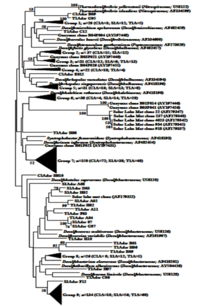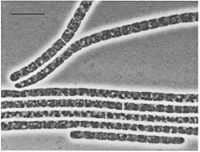Desulfonema limicola
Classification
Domain (Bacteria); Phylum (Progeobacteria); Class (Deltaprogeobacteria); Order (Desulfobacterales); Family (Desulfobacteraceae); Genus (Desulfonema)
Species
Desulfonema limicola
Description and Significance
Sulfate-reducing bacteria were first discovered in 1895 by Beijerinck. Since then, several species of sulfate-reducing bacteria have been described. Desulfonema limicola, which means thread-forming, sulfate reducer, mud-dweller, was described in 1983 by Widdel. [4, 5]
Desulfonema limicola is a filamentous, multicellular, prokaryote bacterium. Cells are approximately 2.3-3 by 2-5 µm. The species is a strict anaerobe that is found in organic-rich, sulfidic sediment samples of marine water. Optimum temperature and pH are 30 degrees Celcius and 7.6, respectively. The morphology of Desulfonema limicola allows the bacterium to glide and migrate within compact sediments. The filamentous cellular organization and the gliding motility set Desulfonema apart from other sulfate-reducing bacteria species and genera. This species is important because it mineralizes dead biomass in sulfate-rich anoxic habitats. [5]
Genome Structure
The genome has yet to be sequenced, however, Gerard Muyze is in the process of doing so. [3]
Cell Structure, Metabolism and Life Cycle
Desulfonema limicola has cell walls characteristic of Gram-negative bacteria, a dense cytoplasm, and an outer membrane with a waved structure. Electron donors and carbon sources metabolized include low-molecular weight compounds from the fermentative breakdown of biomolecules, aromatic compounds, and hydrocarbons, including acetate, succinate, and fumarate. These compounds are oxidized to carbon dioxide. Sulfate is used as the organism as the electron acceptor and is reduced to hydrogen sulfide. [1, 5]
Ecology and Pathogenesis
Desulfonema limicola has been isolated from marine sediments that are anaerobic and sulfate-rich (from the presence of decaying plant material). This bacterium does not grow in freshwater medium. It has an optimum pH of 7.6 and an optimum temperature of 30 deg. C. Desulfonema limicola must have a surface that it can adhere to in order to grow.[1]
Desulfonema limicola is not known to have any pathogenesity.[1]
References
[1] Brysch, K., Schneider, C., Fuchs, G., and Widdel, F. “Lithoautotrophic growth of sulfate-reducing bacteria and description of Desulfobacterium autotrophicum gen. nov., sp. nov.” Arch. Microbiol. 1987. Volume 148. p. 264-274.
[2] Fukui, M., Teske, A., Abums, B., Muyzer, G., and Widdel, F. “Physiology, phylogenetic relationships, and ecology of filamentous sulfate-reducing bacterial (genus Desulfonema).” Arch. Microbiol. 1999. Volume 172. p. 193-203.
[3] "List of Strains - Microbial Genome Sequencing Project." Microbial Genome Sequencing Project. Gordon and Betty Moore Foundation, 2010. Web. 20 Apr. 2010. <http://www.moore.org/microgenome/strain-list.aspx>.
[4] Teske, A., Ramsing, N.B., Habicht, K., Fukui, M., Küver, J., Jørgensen, B.B., Cohen, Y. “Sulfate-reducing bacteria and their activities in cyanobacterial mats of Solar Lake (Sinae, Egypt).” App. Environ. Microbiol. 1998. Volume 64. p. 2943-2951.
[5] Widdel, F., Kohring, G.W., and Mayer, F. “Studies on dissimilatory sulfate-reducing bacteria that decompose fatty acids. III. Characterization of the filamentous gliding Desulfonema limicola gen. nov. sp. nov., and Desulfonema magnum sp. nov.” Arch. Microbiol. Volume 134. p. 286-294.
Author
Page authored by Megan Andrzejak and Laura Bast, student of Prof. Jay Lennon at Michigan State University.
<-- Do not remove this line-->


